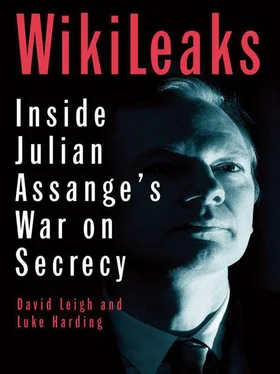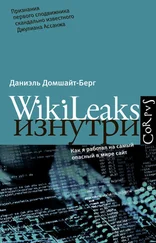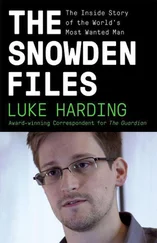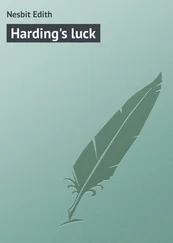Harding, Luke - WikiLeaks - Inside Julian Assange's War on Secrecy
Здесь есть возможность читать онлайн «Harding, Luke - WikiLeaks - Inside Julian Assange's War on Secrecy» весь текст электронной книги совершенно бесплатно (целиком полную версию без сокращений). В некоторых случаях можно слушать аудио, скачать через торрент в формате fb2 и присутствует краткое содержание. Жанр: Старинная литература, на английском языке. Описание произведения, (предисловие) а так же отзывы посетителей доступны на портале библиотеки ЛибКат.
- Название:WikiLeaks: Inside Julian Assange's War on Secrecy
- Автор:
- Жанр:
- Год:неизвестен
- ISBN:нет данных
- Рейтинг книги:3 / 5. Голосов: 1
-
Избранное:Добавить в избранное
- Отзывы:
-
Ваша оценка:
- 60
- 1
- 2
- 3
- 4
- 5
WikiLeaks: Inside Julian Assange's War on Secrecy: краткое содержание, описание и аннотация
Предлагаем к чтению аннотацию, описание, краткое содержание или предисловие (зависит от того, что написал сам автор книги «WikiLeaks: Inside Julian Assange's War on Secrecy»). Если вы не нашли необходимую информацию о книге — напишите в комментариях, мы постараемся отыскать её.
WikiLeaks: Inside Julian Assange's War on Secrecy — читать онлайн бесплатно полную книгу (весь текст) целиком
Ниже представлен текст книги, разбитый по страницам. Система сохранения места последней прочитанной страницы, позволяет с удобством читать онлайн бесплатно книгу «WikiLeaks: Inside Julian Assange's War on Secrecy», без необходимости каждый раз заново искать на чём Вы остановились. Поставьте закладку, и сможете в любой момент перейти на страницу, на которой закончили чтение.
Интервал:
Закладка:
In the end, then, all these anxieties about the fate of informants remained purely theoretical. By the end of the year in which WikiLeaks published its huge dump of information, no concrete evidence whatever had surfaced that any informant had suffered actual reprisals. The only reports were of defence secretary Robert Gates telling a sailor aboard a US warship in San Diego, “We don’t have specific information of an Afghan being killed yet.” CNN reported on 17 October that, according to a senior Nato official in Kabul, “There has not been a single case of Afghans needing protection or to be moved because of the leak.”
As Walsh had predicted, the enemies of WikiLeaks nevertheless did their worst. Admiral Mike Mullen, chairman of the joint chiefs of staff, was among the first. “The truth is they might already have on their hands the blood of some young soldier or that of an Afghan family,” Mullen told a Pentagon news conference four days after the leak. This slogan – “blood on their hands” – was in turn perverted from a speculation into a fact, endlessly repeated, and used as a justification for bloodlust on the part of some US politicians, who seemingly thought they might profit in votes by calling for Assange himself to be murdered. Particularly repellent was hearing the phrase being used by US generals who, as the WikiLeaks documents revealed, had gallons of genuine civilian blood on their own hands.
Assange was starting to prove a volatile partner in several respects. Nick Davies was his chief contact, and the man who had reeled him in for the Guardian . So it was a jolt when the pair fell out. Davies believed he and Assange had developed a rapport, cemented over dinners, jokes, late-night philosophical debates and al fresco dinners in Stockholm’s island old town. “I thought he was clever and interesting and fun to hang around with. The two of us were involved in this rather exciting, very important adventure.” But the day before the Afghan war logs launch, Davies’ phone rang. On the other line was Stephen Grey, a freelance reporter. Grey began: “Guess what? I’ve just been with Julian Assange.” Grey explained that Assange had given him an exclusive TV interview about the blockbusting Afghan war logs. He had also provided material for Channel 4’s website. And there was more bad news: Grey said that Assange had approached CNN and Al Jazeera offering them an interview as well. Davies was fuming. Assange, however, insisted: “It was always part of our agreement that I was going to do this.”
This quarrel did not bode well for the future. Nor did Assange’s growing friction with the New York Times . The NYT were refusing to link directly to the WikiLeaks cable dump from their own website. Bill Keller played it differently to the Guardian and Der Spiegel , who, after some debate internally, both decided to post a link to the WikiLeaks site in the normal way. The New York Times took the equally defensible view that readers – and indeed their own hostile US government – would not see the paper’s staff as detached reporters if they directed readers to WikiLeaks in such a purposeful manner. Keller says: “We feared – rightly, as it turned out – that their trove would contain the names of low-level informants and make them Taliban targets.” Assange was angered at what he saw as pusillanimity by the Americans. He went about declaring in his Australian twang, “They must be punished!” The editor of the New York Times , in turn, came to see Assange as “a self-important quasi-anarchist” Keller recalls. “I talked to Assange by phone a few times, and heard out his complaints. ‘Where’s the respect?’ he demanded. ‘Where’s the respect?’ Another time he called to tell me how much he disliked a profile we had written of Bradley Manning … Assange complained that we had ‘psychologicalised’ Manning and given short shrift to his ‘political awakening’.”
Beneath the surface, all these tensions simmered. But to the public, the launch of the first tranche of war logs about Afghanistan represented a smooth and well-orchestrated media coup. It gave the three papers massive exposure, and turned Julian Assange, for a time, into the world’s most famous man. It was the biggest leak in history – until it was followed by an even bolder set of disclosures about Iraq. These were the two immensely controversial wars which the United States had inflicted on the world, and now, at last, it seemed possible to lift the lid on them.
CHAPTER 9
The Afghanistan war logs
Cyberspace
25 July 2010
“ We are saddened by the innocent lives that were lost as a result of militants’ cowardice ”
US ARMY MAJOR CHRIS BELCHER, AFGHANISTAN
One night in Afghanistan, five heavy rockets, fired from a new type of weapon, came shrieking out of the darkness on to a religious school, a madrassa, completely reducing it to rubble. When the assault helicopters landed and US special forces came tumbling out, they discovered they had killed seven children. Their real target, a top al-Qaida fighter, escaped. This event, one of many during the benighted Afghan war, took place on 17 June 2007, and was described in the following way by the US army’s special operations command news service:
Airstrike in Paktika
BAGRAM AIRFIELD, Afghanistan.
Afghan and Coalition forces conducted an operation in Paktika Province’s Zarghun Shah District late Sunday, which resulted in several militants and seven civilians killed and two militants detained. Credible intelligence named the compound, which contained a mosque and a madrassa, as a suspected safehouse for al-Qaida fighters.
Coalition forces confirmed the presence of nefarious activity occurring at the site before getting approval to conduct an airstrike on the location. Following the strike, residents of the compound confirmed that al-Qaida fighters had been present all day.
Early reporting [suggests] seven children at the madrassa died as a result of the strike. “This is another example of al-Qaida using the protective status of a mosque, as well as innocent civilians, to shield themselves,” said Army Maj Chris Belcher, a Combined Joint Task Force-82 spokesman. “We are saddened by the innocent lives that were lost as a result of militants’ cowardice.”
The real story only emerged from the text of a leaked military log obtained by WikiLeaks three years later, and published worldwide by the Guardian and its partners the New York Times and Der Spiegel . The field report was among the 92,000 allegedly turned over to WikiLeaks founder Julian Assange by US soldier Bradley Manning.
The log disclosed that there had actually been no “airstrike” (whose reconnaissance cameras might indeed have been less inaccurate). Instead, what had happened was a trial of a powerful, if potentially indiscriminate, new missile system – a GPS-guided rocket volley that could be fired from the back of a truck up to 40 miles away, known as HIMARS (high mobility artillery rocket system). The assault was not launched by ordinary “Afghan and Coalition forces” but by a shadowy troop of US killers known as Task Force 373, whose targets were written on a special list. And the rocket attack was not prompted by general “nefarious activity”, but by the hope that a top listed target, Commander Al Libi, was on the premises.
The leaked war log gave the following account (abbreviations have been expanded):
Date2007-06-17 21:00:00
TypeFriendly Action
Title172100Z[ulu time] T[ask] F[orce] 373 OBJ[ective] Lane
Summary
NOTE: The following information (TF-373 and HIMARS) is Classified Secret / NOFORN. The knowledge that TF-373 conducted a HIMARS strike must be kept protected. All other information below is classified Secret / REL[ease] ISAF. [International Security Assistance Force]
Читать дальшеИнтервал:
Закладка:
Похожие книги на «WikiLeaks: Inside Julian Assange's War on Secrecy»
Представляем Вашему вниманию похожие книги на «WikiLeaks: Inside Julian Assange's War on Secrecy» списком для выбора. Мы отобрали схожую по названию и смыслу литературу в надежде предоставить читателям больше вариантов отыскать новые, интересные, ещё непрочитанные произведения.
Обсуждение, отзывы о книге «WikiLeaks: Inside Julian Assange's War on Secrecy» и просто собственные мнения читателей. Оставьте ваши комментарии, напишите, что Вы думаете о произведении, его смысле или главных героях. Укажите что конкретно понравилось, а что нет, и почему Вы так считаете.












